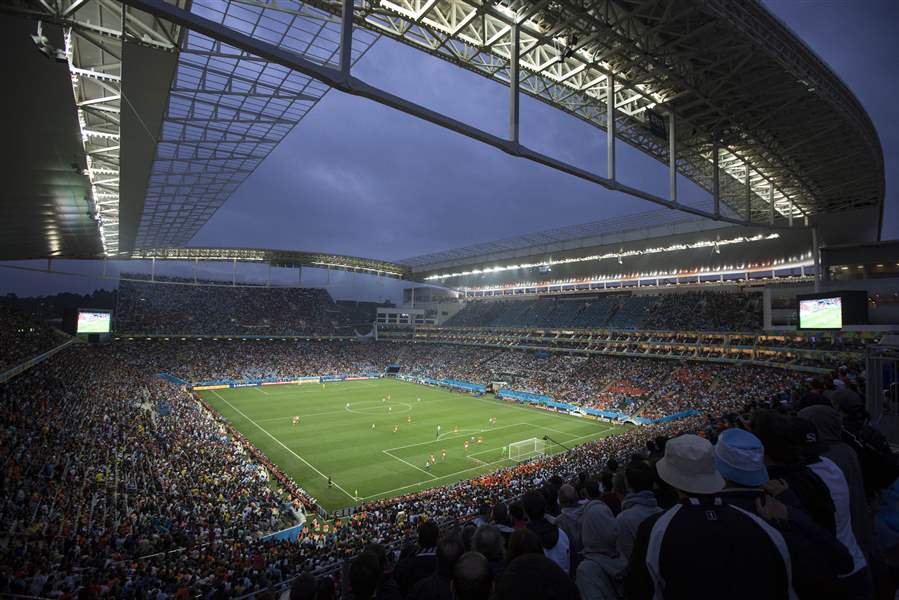
What worries? Overall, Brazil's World Cup scores high on and off the field
7/14/2014
Soccer fans watch the World Cup semifinal match between the Netherlands and Argentina on July 9 in the Itaquerao Stadium, in Sao Paulo, Brazil.
ASSOCIATED PRESS
RIO DE JANEIRO — Brazil’s World Cup organizers can say it now: “Esta tudo bem” — it’s all OK. What was everyone so worried about?
After being plagued by doubts over whether the stadiums would be ready and stay standing, and if Brazil’s people would join in the fun or try to spoil it, their tournament is a winner. Even if the Brazilian team fell disastrously short.
Memorable games, fantastic goals and, overall, one joyous monthlong party from Copacabana beach to the Amazon jungle will be the story of Brazil 2014. The Associated Press takes a look back at the World Cup, rated as one of the best in years despite pre-event worries it could be one of the most shambolic.
THE GAMES:
They were great and the flavor of the football sweetened this World Cup. The goals flew in, giving the tournament a record-equaling goal total and a healthy game average. The quality was high as well: Robin van Persie’s diving header for the Netherlands, Lionel Messi’s moments of magic for Argentina and James Rodriguez’s audacious turn-and-volley for Colombia will be remembered for World Cups to come.
And what about some of the results? The Dutch beating defending champion Spain 5-1. Little Costa Rica making the quarterfinals. And, even if devastated Brazil fans are desperate to forget it, Germany’s 7-1 dismantling of the home team in the semifinals — an awesome display of power and precision.
Apparently, the world was watching too: TV companies in the United States reported record viewing figures for a World Cup, some a 100 percent rise on previous tournaments. FIFA says there were more tweets from across the globe about the Brazil-Germany game than any sports event ever.
THE STADIUMS:
One of the two biggest headaches for Brazil coming into the World Cup. Ultimately, the stadiums weren’t perfect, but they worked out. Chronic delays, accidents and worker deaths marred the construction of some of the 12 venues used across the vast country — like Sao Paulo’s Itaquerao Stadium, where the roof wasn’t completed. Temporary seating was also used there.
But that didn’t detract from the football, and unlike South Africa last time, the stadiums were pretty much full to the brim. FIFA’s final count said Brazil’s average and total attendances were the second-highest ever for a World Cup behind the U.S. in 1994. The average attendance in 2014 was 53,592 and over 3.4 million people watched the 64 games at the stadiums.
SECURITY & ORGANIZATION:
FIFA and Brazilian organizers were given a rude awakening when nearly 100 Chile fans broke into Rio de Janeiro’s Maracana Stadium — the showpiece arena — ahead of a group game and rampaged through a media room, breaking down walls and causing havoc. The incident was deeply embarrassing.
But widespread and violent street protests — the organizers’ other main worry alongside the unfinished stadiums — never happened. Fears of a repeat of the outbursts of anger that overshadowed last year’s Confederations Cup, when over 1 million people took to the streets on one day, were misplaced. There were small protests but they were marginal to the World Cup. More than 25,000 police and soldiers secured Sunday’s final, the biggest security detail in Brazilian history. There was no messing around.
TRANSPORT & INFRASTRUCTURE:
It should be remembered that Brazil broke many of its World Cup promises. When the country was awarded hosting rights in 2007, politicians vowed that $8 billion would be spent on 56 construction projects, including new airports, subway lines and other infrastructure. Fewer than 10 were completed in time for the tournament. Among those delayed was a road overpass in the host city of Belo Horizonte, which collapsed during the World Cup killing two people.
The sometimes rickety existing metro systems in the biggest cities of Sao Paulo and Rio de Janeiro did hold up, however, carrying supporters to stadiums without any major problems. The roads all over were often clogged but that’s an old Brazilian issue and fans just learned to give themselves more time to get to those games.
THE FAN EXPERIENCE:
Unique. On those days when their team wasn’t playing, football followers could explore the huge metropolis of Sao Paulo with its 20 million-plus inhabitants, the golden beaches of Rio de Janeiro or the jungles of the Amazon host city of Manaus in the far north. Many did all of them over the four weeks and still had the energy for the late-night bars and restaurants and their delicious but lethal Caipirinha sugar cane cocktails. Visitors did complain about muggings and credit card fraud, though. Some tourists may have also been surprised by the prices. A great experience, but not always a cheap one.
JUST ONE THING: WHERE WAS PELE?
You can’t say football, World Cup or Brazil without also saying Pele, the greatest player that’s lived and the country’s favorite son. And yet the three-time World Cup winner was a rare sight at the first showcase on his home soil in 64 years, the first since the great man was a nine-year-old kid dreaming of playing at football’s main event.
The star of the show for the closing ceremony should have been an obvious choice. Instead, organizers chose Brazilian supermodel Gisele Bundchen to accompany former Spain international Carles Puyol in bringing the gold trophy out onto the field at the Maracana for the final. It should have been Pele, who has lifted the World Cup more times than anyone else and is probably the biggest reason why Brazil is the spiritual home of football.